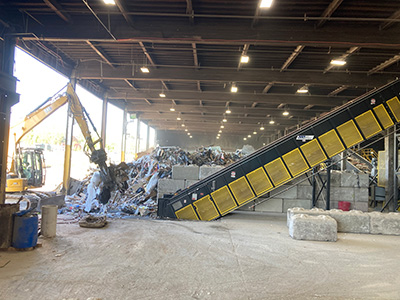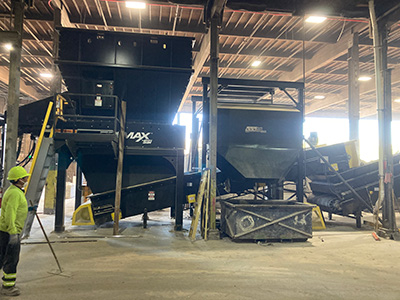Recycling has been a part of our lives now for many years, but what exactly happens to those items that hit an Oregon recycling bin? Do the materials end up in landfills, despite our best efforts, and get shipped overseas, or is today’s scrap metal tomorrow’s new bridge support in Portland? COR was recently awarded an SBA Small Business Innovation and Research (SBIR) Grant to create a system within its line processing that aims to answer those questions about how much waste in Oregon is truly recycled, and what happens to it once it gets separated from the trash.
The goal of SBIR grants is to fund private-sector sustainability projects that increase the commercialization of innovation and stimulate technological advances while also fostering participation by socially/economically disadvantaged individuals. COR’s application met all the criteria and then some. Being awarded the grant was a highlight for COR and sparked a visit by the 27th Administrator of the U.S. Small Business Administration (SBA), Isabella Casillas Guzman and other political figures like Ron Wyden.
 Receiving the grant was just the start of an aggressive and unique sustainability initiative. The grant funds are being put towards developing a real-time recycling inventory management system that has been in the works since our own Chief Operating Officer AJ Simpson envisioned such a system back in 2019. Focusing on COR’s construction waste, recycling, and sustainability services, AJ recognized that the current system, conducting visual inspections of the waste and recycling load delivered from construction sites to estimate how much could be recycled, was inadequate and often inaccurate.
Receiving the grant was just the start of an aggressive and unique sustainability initiative. The grant funds are being put towards developing a real-time recycling inventory management system that has been in the works since our own Chief Operating Officer AJ Simpson envisioned such a system back in 2019. Focusing on COR’s construction waste, recycling, and sustainability services, AJ recognized that the current system, conducting visual inspections of the waste and recycling load delivered from construction sites to estimate how much could be recycled, was inadequate and often inaccurate.
Right now, waste and recycling are dumped on the ground when it arrives and COR inspects it to estimate how much of each type of material is present, looking at recyclables versus trash for sustainability and avoiding landfills. A load might have 50% metal, 20% cardboard, 10% cement, and the remaining 20% trash. This is known as grading the load. We create a waste composition report with this information that is given to the waste generator who then forwards that on to organizations that certify green building practices like LEED. Certification through these organizations is partly based on how much construction material is recycled. The more a waste generator can show they recycle, the more chance they will have to take advantage of a number of incentives for green practices so there’s been much interest in finding more efficient ways to calculate recyclables.
In fact, COR’s hunt to find a better method to create accurate reports mostly came from our conversations with waste generators. While incentives are a plus, our industry is becoming increasingly aware that regulatory requirements for waste recycling are on the horizon and accuracy will be paramount for compliance.
 It’s one thing to know waste is recyclable but the other part of the equation is where does that material go and what is it recycled into. That’s another mysterious part of waste management that we’re planning to address. And, in fact, when we get our system up and running we plan to patent it as a first of its kind. COR has a material passport as our grand vision where we’ll be able to tell waste generators, for example, how much metal was in their waste, who the metal was sold to, and ultimately what product was made from that recycled material. This is an ambitious plan as many businesses would have to come on board, but with new legislation anticipated, there will be increased interest. If we can put in place a full system like this in Portland, which we plan to have ready in about a year’s time, we’d then be ready to solicit this innovation to material handling facilities and public agencies everywhere.
It’s one thing to know waste is recyclable but the other part of the equation is where does that material go and what is it recycled into. That’s another mysterious part of waste management that we’re planning to address. And, in fact, when we get our system up and running we plan to patent it as a first of its kind. COR has a material passport as our grand vision where we’ll be able to tell waste generators, for example, how much metal was in their waste, who the metal was sold to, and ultimately what product was made from that recycled material. This is an ambitious plan as many businesses would have to come on board, but with new legislation anticipated, there will be increased interest. If we can put in place a full system like this in Portland, which we plan to have ready in about a year’s time, we’d then be ready to solicit this innovation to material handling facilities and public agencies everywhere.
And this is now just aimed toward construction and demolition material recycling. We would love to expand our operations to handle day-to-day household and business recycling too. The roadblock to that now is, consumers aren’t often interested in where their water bottle goes and what’s made from it. But they should be, and if waste haulers are able to tout that the bottles and cans they collect from consumers are all turned into other products, the interest in the life cycle of recyclables might just grow.
If you’re ready to learn more about or assist us with our plans to divert waste from landfills, contact us today.